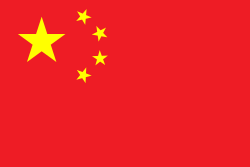in Standard Chinese, the first of these phrases would be: 三 sān three 本 běn CLASSIFIER 书 shū books 三 本 书 sān běn shū three CLASSIFIER books "three books"...
79 KB (8,986 words) - 14:27, 22 June 2025
In the tables, the first two columns contain the Chinese characters representing the classifier, in traditional and simplified versions when they differ...
41 KB (368 words) - 18:40, 23 November 2024
general classifier, with almost any noun, taking the place of more specific classifiers. The noun in such phrases may be omitted, if the classifier alone...
51 KB (6,284 words) - 03:35, 26 May 2025
to use the general classifier gè (个; 個) in place of other specific classifiers. In Chinese, the difference between words and Chinese characters is often...
82 KB (10,851 words) - 05:19, 4 June 2025
Measure word (redirect from Numerical classifier)
yi-ge Tang: Classifiers and mass-classifiers". Tsing Hua Journal of Chinese Studies. 28 (3). Tai, James H.-Y. (1994). "Chinese classifier systems and...
7 KB (810 words) - 05:53, 21 October 2024
languages, such as Mandarin Chinese, treat all nouns as mass nouns, and need to make use of a noun classifier (see Chinese classifier) to add numerals and other...
7 KB (849 words) - 18:02, 14 June 2025
by a Chinese substratum. From the 17th to the 19th centuries, there was also Chinese Pidgin English spoken in Cantonese-speaking portions of China. Chinese...
17 KB (1,910 words) - 13:38, 24 June 2025
Ensemble learning (redirect from Ensemble classifier)
optimal classifier represents a hypothesis that is not necessarily in H {\displaystyle H} . The hypothesis represented by the Bayes optimal classifier, however...
53 KB (6,691 words) - 19:58, 23 June 2025
Chinese units of measurement, known in Chinese as the shìzhì ("market system"), are the traditional units of measurement of the Han Chinese. Although...
46 KB (2,182 words) - 16:19, 19 June 2025
Republic of China" (simplified Chinese: 中华人民共和国; traditional Chinese: 中華人民共和國; pinyin: Zhōnghuá rénmín gònghéguó). The shorter form is "China" (中国; 中國;...
332 KB (29,790 words) - 00:27, 21 June 2025
varieties require an intervening classifier when a noun is preceded by a demonstrative or numeral. The inventory of classifiers tends to be larger in the south...
109 KB (10,205 words) - 08:05, 25 June 2025
Mongols in China, also known as Mongolian Chinese or Chinese Mongols, are ethnic Mongols who live in China. They are one of the 56 ethnic groups recognized...
23 KB (2,321 words) - 12:30, 29 May 2025
Chinese numerals are words and characters used to denote numbers in written Chinese. Today, speakers of Chinese languages use three written numeral systems:...
54 KB (2,988 words) - 16:02, 4 May 2025
The Chinese spoon or Chinese soup spoon is a type of spoon with a short, thick handle extending directly from a deep, flat bowl. It is a regular utensil...
5 KB (539 words) - 17:04, 12 November 2024
Chinese culture (simplified Chinese: 中华文化; traditional Chinese: 中華文化; pinyin: Zhōnghuá wénhuà) is one of the world's earliest cultures, said to originate...
112 KB (12,932 words) - 06:43, 25 May 2025
Chinese (simplified Chinese: 汉语; traditional Chinese: 漢語; pinyin: Hànyǔ; lit. 'Han language' or 中文; Zhōngwén; 'Chinese writing') is a group of languages...
84 KB (8,946 words) - 09:07, 24 June 2025
Traditional Chinese characters are a standard set of Chinese character forms used to write Chinese languages. In Taiwan, the set of traditional characters...
25 KB (2,309 words) - 07:58, 29 May 2025
Wuxing (Chinese: 五行; pinyin: wǔxíng), usually translated as Five Phases or Five Agents, is a fivefold conceptual scheme used in many traditional Chinese fields...
38 KB (2,973 words) - 09:50, 25 June 2025
Standard Chinese (simplified Chinese: 现代标准汉语; traditional Chinese: 現代標準漢語; pinyin: Xiàndài biāozhǔn hànyǔ; lit. 'modern standard Han speech') is a modern...
84 KB (8,309 words) - 15:39, 25 May 2025
Chinese pronouns are pronouns in the Chinese languages. This article highlights Mandarin Chinese pronouns. There are also Cantonese pronouns and Hokkien...
24 KB (1,904 words) - 01:11, 24 June 2025
Peranakan Chinese (/pəˈrɑːnəˌkɑːn, -kən/) are an ethnic group defined by their genealogical descent from the first waves of Southern Chinese settlers to...
119 KB (12,891 words) - 19:08, 22 June 2025
Mandarin (/ˈmændərɪn/ MAN-dər-in; simplified Chinese: 官话; traditional Chinese: 官話; pinyin: Guānhuà; lit. 'officials' speech') is the largest branch of...
85 KB (8,811 words) - 12:31, 23 June 2025
Chinese art Chinese art is visual art that originated in or is practiced in China, Greater China or by Chinese artists. Art created by Chinese residing...
129 KB (14,757 words) - 07:02, 25 June 2025
Chinese herbology (traditional Chinese: 中藥學; simplified Chinese: 中药学; pinyin: zhōngyào xué) is the theory of traditional Chinese herbal therapy, which...
75 KB (6,547 words) - 20:01, 20 June 2025
Simplified Chinese characters are one of two standardized character sets widely used to write the Chinese language, with the other being traditional characters...
60 KB (6,652 words) - 23:17, 23 June 2025
the People's Republic of China classifies towns as fourth-level administrative units, along with, for example, townships (Chinese: 乡; pinyin: xiāng). A township...
5 KB (508 words) - 19:39, 4 May 2025
other symbols. Chinese characters are logographs used to write the Chinese languages and others from regions historically influenced by Chinese culture. Of...
121 KB (14,155 words) - 22:40, 31 May 2025
difficult to classify according to traditional grammar. Both Classical Chinese and Modern Standard Chinese make use of particles. In Chinese, particles...
16 KB (933 words) - 09:12, 27 May 2025
and practice and organized them into what they called "Chinese medicine". In the 1950s, the Chinese government sought to revive traditional medicine (including...
225 KB (23,494 words) - 18:32, 3 June 2025
Romanization of Chinese is the use of the Latin alphabet to transliterate Chinese. Chinese uses a logographic script and its characters do not represent...
39 KB (4,966 words) - 12:55, 31 May 2025

















